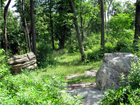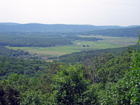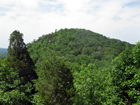From the parking area, proceed ahead on the paved road, which curves to the right. You will pass a sign marking the trailhead of the Summit and Swamp Trails, and go by another parking area to the right. At the end of the second parking area (where the pavement ends), you'll notice a sign marking the start of the blue-blazed Spring Trail. Follow this trail ahead along a woods road, passing...
Hike Description:
From the parking area, proceed ahead on the paved road, which curves to the right. You will pass a sign marking the trailhead of the Summit and Swamp Trails, and go by another parking area to the right. At the end of the second parking area (where the pavement ends), you'll notice a sign marking the start of the blue-blazed Spring Trail. Follow this trail ahead along a woods road, passing through a clearing. Soon, the trail begins to run along the base of the south side of the ridge.
A short distance beyond, the Spring Trail passes near the edge of a rocky ravine, with views over the ravine from rock outcrops to the right of the trail. It then swings left and continues along the base of the ridge on a relatively level footpath. At 0.6 mile, after passing cliffs on the left, the trail turns left and makes a short but steep ascent to the ridge, where it reaches a junction with the yellow-blazed Summit Trail.
Turn left, following the yellow blazes, which head southwest along the ridge of Jenny Jump Mountain. According to folklore, the mountain derives its name from Jenny Lee, a young woman living with her aged father on the mountain. While in a remote area on the mountain, she was accosted by (depending on the account) either a spurned suitor or a Native American. After being chased to the edge of the cliff, she chose “death before dishonor” and jumped. (In one account, however, she lived to tell the tale.)
After walking along the summit ridge for about 300 feet, you’ll reach a west-facing viewpoint over the Delaware Water Gap fr om a rock outcrop to the right of the trail. A bench has been placed here. Then, in 0.2 mile, you’ll come to two large glacial erratics in an open area. The one on the right is form
om a rock outcrop to the right of the trail. A bench has been placed here. Then, in 0.2 mile, you’ll come to two large glacial erratics in an open area. The one on the right is form ed of sandstone with calcareous layers, while the one on the left is composed of Precambrian granite gneiss (which forms the underlying bedrock). About 100 feet further along the trail, a side trail leads left to a southeast-facing viewpoint, which includes both forest and the fertile fields of the Great Meadows.
ed of sandstone with calcareous layers, while the one on the left is composed of Precambrian granite gneiss (which forms the underlying bedrock). About 100 feet further along the trail, a side trail leads left to a southeast-facing viewpoint, which includes both forest and the fertile fields of the Great Meadows.
The yellow trail now widens into a woods road and, in 0.2 mile, turns right and begins a steady descent. Just beyond this turn, at a flat rock along the trail, a side trail leads left to a panoramic viewpoint from a rock outcrop a mid cedars. The Pinnacle is directly ahead, with the farmlands of the Great Meadows visible to the left. Glacial striations are clearly visible on the surface of the rock outcrop.
mid cedars. The Pinnacle is directly ahead, with the farmlands of the Great Meadows visible to the left. Glacial striations are clearly visible on the surface of the rock outcrop.
After enjoying the view, return to the main trail and turn left, continuing to descend. Soon, the red-blazed Swamp Trail joins from the right. After skirting Campsite #9, the joint red and yellow trails bear left, pass two cabins, and end at the parking area where the hike began.
Publication: Submitted by Daniel Chazin on 08/24/2004 updated/verified on 01/04/2024This short loop hike climbs to several panoramic viewpoints and passes interesting glacial erratics.
Hike Checklist:
Whether you are going for a day hike or backpacking overnight, it is good practice to carry what we call The Hiking Essentials. These essentials will help you enjoy your outing more and will provide basic safety gear if needed. There may also be more essentials, depending on the season and your needs.
The Essentials
Hiking Shoes or Boots
Water - Two quarts per person is recommended in every season. Keep in mind that fluid loss is heightened in winter as well as summer. Don't put yourself in the position of having to end your hike early because you have run out of water.
Map - Know where you are and where you are going. Many of our hiking areas feature interconnecting network of trails. Use a waterproof/tear-resistant Tyvek Trail Conference map if available or enclose your map in a Ziplock plastic bag. If you have a mobile device, download Avenza’s free PDF Maps app and grab some GPS-enhanced Trail Conference maps (a backup Tyvek or paper version of the map is good to have just in case your batteries die or you don't have service). Check out some map-reading basics here.
Food - Snacks/lunch will keep you going as you burn energy walking or climbing. Nuts, seeds, and chocolate are favorites on the trail.
Sunscreen and insect repellent
Rain Gear and Extra Clothing - Rain happens. So does cold. Be prepared for changing weather. Avoid cotton--it traps water against your skin and is slow to dry. If you are wearing wet cotton and must return to your starting point, you risk getting chills that may lead to a dangerous hypothermia. Choose synthetic shirts, sweaters and/or vests and dress in layers for easy on and off.
Compass - A simple compass is all you need to orient you and your map to magnetic north.
Light - A flashlight or small, lightweight headlamp will be welcome gear if you find yourself still on the trail when darkness falls. Check the batteries before you start out and have extras in your pack.
First Aid Kit - Keep it simple, compact, and weatherproof. Know how to use the basic components.
Firestarter and Matches - In an emergency, you may need to keep yourself or someone else warm until help arrives. A firestarter (this could be as simple as leftover birthday candles that are kept inside a waterproof container) and matches (again, make sure to keep them in a waterproof container) could save a life.
Knife or Multi-tool - You may need to cut a piece of moleskin to put over a blister, repair a piece of broken equipment, or solve some other unexpected problem.
Emergency Numbers - Know the emergency numbers for the area you're going to and realize that in many locations--especially mountainous ones, your phone will not get reception.
Common Sense - Pay attention to your environment, your energy, and the condition of your companions. Has the weather turned rainy? Is daylight fading? Did you drink all your water? Did your companion fail to bring rain gear? Are you getting tired? Keep in mind that until you turn around you are (typically) only half-way to completing your hike--you must still get back to where you started from! (Exceptions are loop hikes.)
Check the weather forecast before you head out. Know the rules and regulations of the area.
The Leave No Trace Seven Principles
Plan Ahead and Prepare
- Know the regulations and special concerns for the area you'll visit.
- Prepare for extreme weather, hazards, and emergencies.
- Schedule your trip to avoid times of high use.
- Visit in small groups when possible. Consider splitting larger groups into smaller groups.
- Repackage food to minimize waste.
- Use a map and compass to eliminate the use of marking paint, rock cairns or flagging.
Travel and Camp on Durable Surfaces
- Durable surfaces include established trails and campsites, rock, gravel, dry grasses or snow.
- Protect riparian areas by camping at least 200 feet from lakes and streams.
- Good campsites are found, not made. Altering a site is not necessary.
- In popular areas:
- Concentrate use on existing trails and campsites.
- Walk single file in the middle of the trail, even when wet or muddy.
- Keep campsites small. Focus activity in areas where vegetation is absent.
- In pristine areas:
- Disperse use to prevent the creation of campsites and trails.
- Avoid places where impacts are just beginning.
- Pack it in, pack it out. Inspect your campsite and rest areas for trash or spilled foods. Pack out all trash, leftover food and litter.
- Deposit solid human waste in catholes dug 6 to 8 inches deep, at least 200 feet from water, camp and trails. Cover and disguise the cathole when finished.
- Pack out toilet paper and hygiene products.
- To wash yourself or your dishes, carry water 200 feet away from streams or lakes and use small amounts of biodegradable soap. Scatter strained dishwater.
- Preserve the past: examine, but do not touch cultural or historic structures and artifacts.
- Leave rocks, plants and other natural objects as you find them.
- Avoid introducing or transporting non-native species.
- Do not build structures, furniture, or dig trenches.
- Campfires can cause lasting impacts to the backcountry. Use a lightweight stove for cooking and enjoy a candle lantern for light.
- Where fires are permitted, use established fire rings, fire pans, or mound fires.
- Keep fires small. Only use sticks from the ground that can be broken by hand.
- Burn all wood and coals to ash, put out campfires completely, then scatter cool ashes.
- Observe wildlife from a distance. Do not follow or approach them.
- Never feed animals. Feeding wildlife damages their health, alters natural behaviors, and exposes them to predators and other dangers.
- Protect wildlife and your food by storing rations and trash securely.
- Control pets at all times, or leave them at home.
- Avoid wildlife during sensitive times: mating, nesting, raising young, or winter.
Be Considerate of Other Visitors
- Respect other visitors and protect the quality of their experience.
- Be courteous. Yield to other users on the trail.
- Step to the downhill side of the trail when encountering pack stock.
- Take breaks and camp away from trails and other visitors.
- Let nature's sounds prevail. Avoid loud voices and noises.
The Trail Conference is a 2015 Leave No Trace partner.
(c) Leave No Trace Center for Outdoor Ethics: www.LNT.org.


